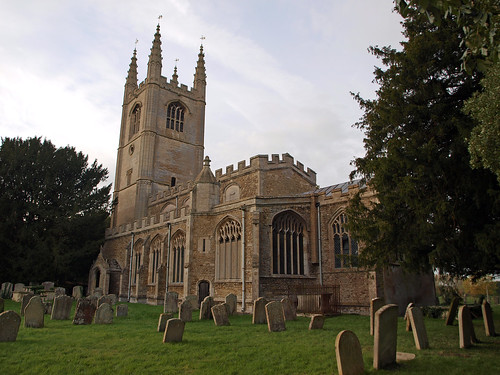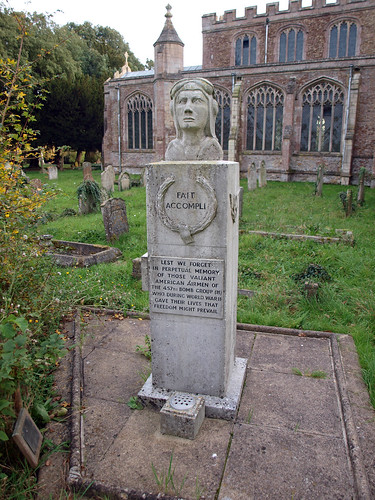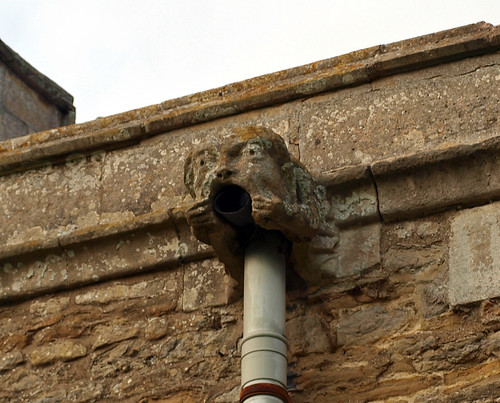This was definitely the church of the day set in a stunning location this peculiar concoction of a church is outstanding and the interior looks to match the exterior.
I did the interior in April 2017 and it probably exceeded my expectations. The interior is vast and, as all CCT churches should be, full of bird and bat shit, monuments and most of all interest. Absolutely stunning.
ALL SAINTS. A large and important church, all of c.1500, with a W tower truly monumental. It is ashlar-faced and of four stages and has panelled polygonal buttresses (cf. Cambridge), a base frieze and a panelled top frieze, a surprising recessed doorway with a small pointed tunnel-vault, a transomed (over restored) W Window of five lights, then, above small two-light windows, round windows, looking C17 in their details, four-light bell-openings under four-centred arches, and big pinnacles re-done in 1638 by Sir Thomas Cotton. The rest of the church is cobble. Embattled nave and aisles, four-light aisle windows, three-light clerestory windows (except for the much wider W bay, which has five-light windows), a higher rood-stair turret, and a chancel only projecting by one bay beyond the chapels. Internally the greatest surprise is due to the restorations of the C19. The tower was originally open to the nave by a high arch, and at that height there was a vault. Now there is a low W entrance hall with a tierceron-star vault and as high up as the original vault a plaster vault. The arcades are of four bays with a very complex Perp section to the piers and capitals only towards the arch openings. The aisle roofs stand on the wall side on shafts carried up from the floor. The chancel chapels are of only one bay. In the chancel very handsome SEDILIA, straight-topped with three little hanging vaults. The seat front has a frieze of reticulation units. The PISCINA has a shelf. - FONT. Octagonal, Late Norman, with intersecting pointed arches on colonnettes. - SCREENS. To the S chapel, of broad one-light divisions with ogee arches. - To the N chapel simpler. - (CHAIR. High-backed Gothic armchair, probably late C14. The back has a blank panel with a cusped and subcusped arch.)* - PEWS. 1841, and characteristic of the date. - (FRONTAL. Parts of two Italian C17 maniples and two stoles. Silver embroidery on pink silk.) - PLATE. Large foreign Plate; Paten on foot of Britannia silver, 1702-3; Britannia silver Cup, 1711-12.
MONUMENTS. Conington is uncommonly rich. The series starts with the memorable Purbcck-marble effigy of a Franciscan tertiary, a young face, perhaps someone who joined, as was not unusual, shortly before he died to be buried a religious. It is a noble, very sensitive piece. The date must be about 1300. - Then, all of about 1600, the memorial tablet between two columns to Thomas (inscribed XIII) Cotton d. 1519 and his Wife and in the same position in the other aisle that to Prince Henry of Scotland,** and one much larger to Thomas (XV) and Thomas (XVI) Cotton and their wives with two arches and columns and an upper display of strapwork and heraldry, and opposite it in the other aisle that to David King of Scotland in two tiers with columns. In the upper part lies just a crown in the arch between the two columns. - Sir Robert Cotton d. 1631, the famous antiquary whose collection of manuscripts is now in the British Museum, and Sir Thomas d. 1662, both erected by Sir John about 1675 or thereabouts. The composition and details of the two tablets are identical except that Sir Robert’s bust is in an oval recess and the garland below is of laurel, whereas Sir Thomas’s is in a circular recess, and the garland is different. In spite of the identity in so many ways, the sculptural quality differs. The bust of Sir Thomas is good, that of Sir Robert outstanding. Who was capable at the time of characterizing so strikingly and modelling so perfectly? - Sir John d. 1702 and his wife, also d. 1702, two identical tablets with portrait medallions at the top. Very similar to the Cotton monument at Conington, Cambridgeshire, dated 1697 and signed by Grinling Gibbons.
* As the brackets indicate, I have not seen this chair. Mr McHardy doubts that it is medieval. He thinks it may belong to the pews. Photographs make me inclined to believe the date of the RCHM, but with the proviso of heavy restoration about 1840.
** Members of the Scottish royal family were lords of the manor in the C12 and early C13.
CONINGTON. It is famous as the home of the Cottons, and their 16th century castle still stands, a splendid spectacle with quaint gables and grey chimneys. It stirs us to remember that its walls have stones which must have been among the last things Mary Queen.of Scots would see as she walked to the block, for the stones came from Fotheringhay. A mile or so away is a round hill, once a fort, and close by is a farm still bearing the proud name of Bruce’s Castle.
A splendid spectacle, too, is this 15th century church, its lovely chancel, its beautiful great windows, and its impressive tower, all the work of master hands. Everywhere there is dignity. Seen from a churchyard shaded by yews, it has the strength of a castle and the charm of a palace, the tower with four great pinnacles like spires.
Perhaps we come to see the Conington tombs, a proud assemblage of those fashionable monuments beloved in their day but not in ours. Four of them were put here by Sir Robert Cotton, the antiquary who built up a famous library and built Conington Castle partly from the ruins of Fotheringhay. On one of these monuments the proud Sir Robert put the royal arms of Scotland with crowns and shields and unicorns, and another is to Prince Henry of Scotland, from whom Sir Robert claimed descent. There are marble medallions of Sir John Cotton and his wife, another of Sir Thomas, and one of Sir Robert himself, who came to lie among the monuments of his ancestors in 1631.
But older than the Cottons, older than anything else in the church, is the marble figure of a 13th century man in habit and cowl with a knotted cord hanging from his waist.
The chancel has a fine canopied stone seat, a 13th century font; 16th century oak screens, an iron-bound chest, an ancient painting of St George and the Dragon, and an altar table with a frontal which has in it 17th century fragments of Italian robes embroidered with silver flowers. In the tower is a broken stone on which is an engraving of a 15th century crucifix with a figure on either side and a heraldic shield. There is a stone in the north aisle marking the burial place of a curate of Holme named Johnson, who saved Oliver Cromwell’s life when he fell from his horse into the river.
The story is told that a curate of Conington saved Cromwell’s life from drowning and that, on being asked if he remembered it, said to Oliver in later years, “Yes, but I wish I had put you in rather than see you in arms against your king.”
But what will seem to most people its most unexpected and dramatic possession is a stately chair like a wooden throne, its arm-rests adorned with carvings of angels, swans, and doves, most attractive little figures. It is said to have been an abbot’s chair at Peterborough, but its historic interest is that it is believed to have been used by Mary Queen of Scots as she lay waiting for death at Fotheringhay.
By three doors still swinging on their hinges men and women have been coming to see the glory of this place for 400 years, and we do not doubt that the doors will be swinging still in 400 years more.
Robert Bruce’s Descendant and His Treasures
BORN at Denton, three miles away, Robert Bruce Cotton (Bruce because he claimed descent from Robert Bruce) had the fortune to be sent as a boy to Westminster School, where was sown the seed that was to furnish a unique harvest for the advantage of mankind.
After his course at Cambridge he returned to London and settled down at a house wlwse site the House of Lords now covers, Cotton House, in which Charles Stuart was to lodge throughout his trial. Here Cotton began that collection of books, manuscripts, coins, and other riches of antiquity which brought him European fame.
The dissolution of the monasteries had broken up and scattered the literary treasures of ages, and many were perishing, to leave irremediable gaps in knowledge. The hour brought the man, and the man was Cotton. Deeply learned, he had that passion for literature which animated Chaucer’s parson, and he had ample wealth to gratify his desires.
He bought old manuscripts as an act of piety, but he read them, so that he became the foremost authority on English history and precedents, and to him the King and Parliament turned when guidance was necessary on questions of precedence, taxation, or constitutional law. His treasures and the joy with which he lent them brought him friendships beyond compare. At his house were to be seen Bacon, Ben Jonson, Selden, Stow, Speed (“lighting his taper” at his patron’s torch), Bodley, Pym, Wentworth, Coke, everybody of note in learning and letters.
He helped Raleigh with documents for his History, written during his imprisonment in the Tower; he collaborated with Camden; Bacon, Stow, and Speed worked in his library. His Saxon charters are the very foundation of the history of pre-Norman England. He himself wrote history and antiquarian tracts and pamphlets, but it is as collector and source of information that he remains unique. His greatest acquisitions were two of the four surviving copies of Magna Carta, one given him by a friend, and the other bought for fourpence from a tailor who was about to cut it up for stiffening a collar! At first a favourite of James and one of his baronets, Cotton was the firm friend of Carr, the royal favourite, whose part in the Overbury murder landed Cotton in the Tower as a very distant accessory long after the fact. His views on national liberty lost him the favour of Charles, and he was imprisoned on a trumped-up charge and his library taken from him.
He was eventually liberated, but never recovered his treasures, which, though restored to his family by Act of Parliament, became in 1702 a national possession, the Cottonian Library now housed magnificently in the British Museum.
A splendid spectacle, too, is this 15th century church, its lovely chancel, its beautiful great windows, and its impressive tower, all the work of master hands. Everywhere there is dignity. Seen from a churchyard shaded by yews, it has the strength of a castle and the charm of a palace, the tower with four great pinnacles like spires.
Perhaps we come to see the Conington tombs, a proud assemblage of those fashionable monuments beloved in their day but not in ours. Four of them were put here by Sir Robert Cotton, the antiquary who built up a famous library and built Conington Castle partly from the ruins of Fotheringhay. On one of these monuments the proud Sir Robert put the royal arms of Scotland with crowns and shields and unicorns, and another is to Prince Henry of Scotland, from whom Sir Robert claimed descent. There are marble medallions of Sir John Cotton and his wife, another of Sir Thomas, and one of Sir Robert himself, who came to lie among the monuments of his ancestors in 1631.
But older than the Cottons, older than anything else in the church, is the marble figure of a 13th century man in habit and cowl with a knotted cord hanging from his waist.
The chancel has a fine canopied stone seat, a 13th century font; 16th century oak screens, an iron-bound chest, an ancient painting of St George and the Dragon, and an altar table with a frontal which has in it 17th century fragments of Italian robes embroidered with silver flowers. In the tower is a broken stone on which is an engraving of a 15th century crucifix with a figure on either side and a heraldic shield. There is a stone in the north aisle marking the burial place of a curate of Holme named Johnson, who saved Oliver Cromwell’s life when he fell from his horse into the river.
The story is told that a curate of Conington saved Cromwell’s life from drowning and that, on being asked if he remembered it, said to Oliver in later years, “Yes, but I wish I had put you in rather than see you in arms against your king.”
But what will seem to most people its most unexpected and dramatic possession is a stately chair like a wooden throne, its arm-rests adorned with carvings of angels, swans, and doves, most attractive little figures. It is said to have been an abbot’s chair at Peterborough, but its historic interest is that it is believed to have been used by Mary Queen of Scots as she lay waiting for death at Fotheringhay.
By three doors still swinging on their hinges men and women have been coming to see the glory of this place for 400 years, and we do not doubt that the doors will be swinging still in 400 years more.
Robert Bruce’s Descendant and His Treasures
BORN at Denton, three miles away, Robert Bruce Cotton (Bruce because he claimed descent from Robert Bruce) had the fortune to be sent as a boy to Westminster School, where was sown the seed that was to furnish a unique harvest for the advantage of mankind.
After his course at Cambridge he returned to London and settled down at a house wlwse site the House of Lords now covers, Cotton House, in which Charles Stuart was to lodge throughout his trial. Here Cotton began that collection of books, manuscripts, coins, and other riches of antiquity which brought him European fame.
The dissolution of the monasteries had broken up and scattered the literary treasures of ages, and many were perishing, to leave irremediable gaps in knowledge. The hour brought the man, and the man was Cotton. Deeply learned, he had that passion for literature which animated Chaucer’s parson, and he had ample wealth to gratify his desires.
He bought old manuscripts as an act of piety, but he read them, so that he became the foremost authority on English history and precedents, and to him the King and Parliament turned when guidance was necessary on questions of precedence, taxation, or constitutional law. His treasures and the joy with which he lent them brought him friendships beyond compare. At his house were to be seen Bacon, Ben Jonson, Selden, Stow, Speed (“lighting his taper” at his patron’s torch), Bodley, Pym, Wentworth, Coke, everybody of note in learning and letters.
He helped Raleigh with documents for his History, written during his imprisonment in the Tower; he collaborated with Camden; Bacon, Stow, and Speed worked in his library. His Saxon charters are the very foundation of the history of pre-Norman England. He himself wrote history and antiquarian tracts and pamphlets, but it is as collector and source of information that he remains unique. His greatest acquisitions were two of the four surviving copies of Magna Carta, one given him by a friend, and the other bought for fourpence from a tailor who was about to cut it up for stiffening a collar! At first a favourite of James and one of his baronets, Cotton was the firm friend of Carr, the royal favourite, whose part in the Overbury murder landed Cotton in the Tower as a very distant accessory long after the fact. His views on national liberty lost him the favour of Charles, and he was imprisoned on a trumped-up charge and his library taken from him.
He was eventually liberated, but never recovered his treasures, which, though restored to his family by Act of Parliament, became in 1702 a national possession, the Cottonian Library now housed magnificently in the British Museum.



No comments:
Post a Comment